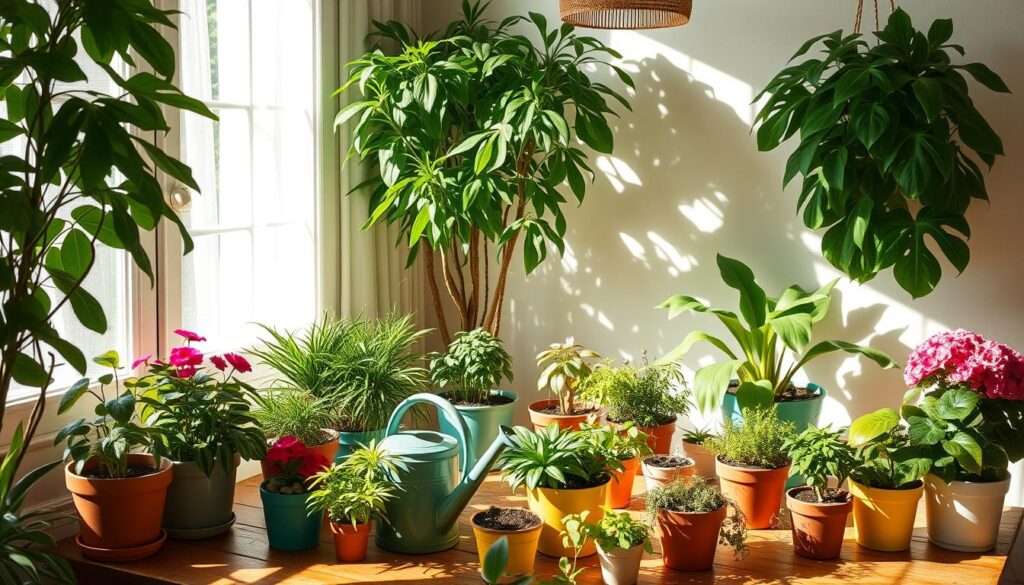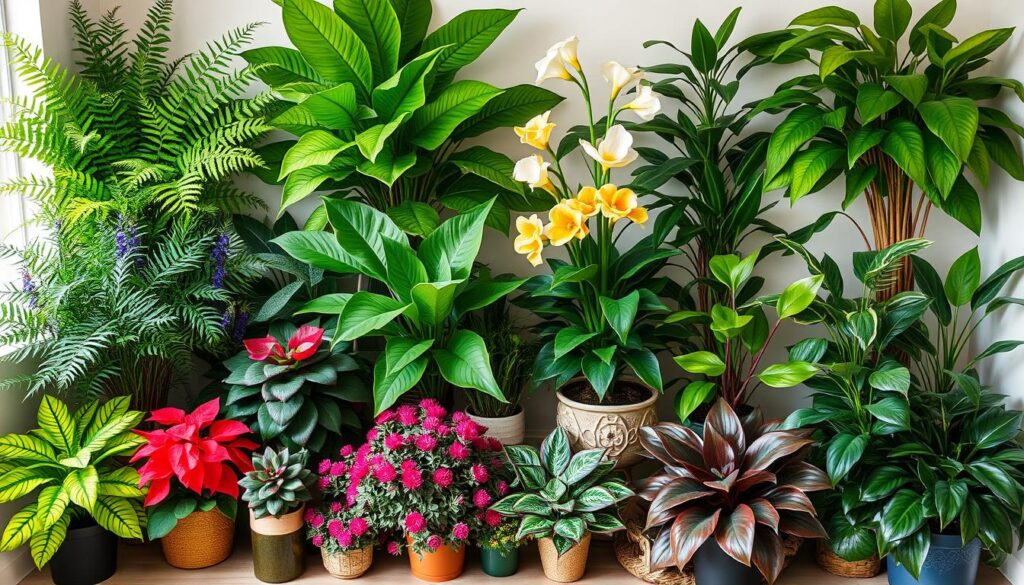Did you know that nearly 80% of indoor plant owners think the seasons change their plants a lot? Yet, only about 35% actually change how they care for them. It’s important to know how to care for your indoor plants in each season. This way, they stay healthy and look great all year.
This guide will show you how to care for your plants in every season. You’ll learn tips for each time of year to help your indoor garden grow. Get ready to make your plants happy and healthy all year!
Key Takeaways
- The needs of indoor plants vary significantly with each season.
- Adjusting light, watering, and humidity levels can optimize plant health.
- Recognizing signs of stress is essential for timely intervention.
- Planning a care schedule helps maintain consistent plant health.
- Choosing appropriate plants for each season enhances indoor aesthetics.
Understanding Seasonal Changes in Indoor Plants
Indoor plants feel the change of seasons, affecting their health and growth. Knowing how to care for plants in each season is key. This helps them thrive in their environment.
The Impact of Seasons on Plant Growth
Seasonal changes affect indoor plants in many ways. In spring, plants grow fast because of more light and warmer temperatures. But in winter, they slow down and rest. It’s important to adjust care based on these changes.
Signs Your Plant Needs Seasonal Attention
It’s crucial to notice when plants need seasonal care. Look out for these signs:
- Yellowing leaves: This can mean too little light or too much water, especially with daylight changes.
- Slow growth: If plants aren’t growing as they should, it might be due to the wrong season.
- Pest infestations: Pests can get busier with the seasons, so keep an eye out.
Winter Indoor Plant Care Essentials
Winter is here, and taking care of your indoor plants is key. The cold months bring less light and lower humidity. Knowing how to care for your plants during this time is vital for their health.
Adjusting Light Levels in Winter
Indoor plants get less natural light in winter, which slows their growth. To help, rotate your plants to get even light. If it’s too dark, artificial grow lights can be a good solution.
Watering Needs in Cold Months
Indoor plants need less water in winter because they grow slower. Adjust your watering schedule to avoid overwatering. Check the soil moisture before watering. If it’s dry up to an inch, it’s time to water.
Keeping Humidity in Check
Low temperatures mean lower humidity, which harms many plants. Use humidity trays or mist your plants to keep moisture levels right. These steps will keep your plants thriving even in the cold.
Spring Care for Indoor Plants
Spring brings warmth and the perfect time to care for your indoor plants. This season is great for growth, making it a perfect time for spring care. With the right care, your plants will grow and bloom beautifully.
Encouraging New Growth and Budding
Spring means more light and longer days for your plants. Adjust your watering to keep the soil moist but not wet. Make sure each plant gets enough light to grow well.
Fertilizing Your Plants in Spring
Fertilizing is key in spring for your indoor plants. Choose a balanced fertilizer for your plants. Liquid fertilizers are best for quick nutrient uptake. Fertilize every 4-6 weeks to help them grow. Always follow the fertilizer instructions to avoid harming your plants.
Pruning for Better Blooms
Pruning keeps your plants healthy and encourages blooms. Remove dead or yellow leaves to help new growth. Use sharp scissors to avoid damaging the leaves. Prune flowering plants after they bloom for more flowers next year. This also improves air flow.
| Activity | Timing | Notes |
|---|---|---|
| Adjust watering | Start of spring | Ensure soil remains moist |
| Fertilizing | Every 4-6 weeks | Use balanced fertilizer |
| Pruning | After flowering | Focus on dead leaves and stems |
Follow these tips for a thriving indoor garden this spring. With proper fertilization and pruning, your plants will bloom beautifully for the warmer months.
Summer Indoor Plant Maintenance
Summer brings special challenges for indoor plants. The heat and long days mean you need to change how you care for them. It’s key to manage the heat and sunlight well.
Also, watch how much you water. Signs of too much water are important to spot. Knowing these tips helps your plants stay healthy in the hot weather.
Managing Heat and Sun Exposure
Plants get stressed from more heat and sun in summer. Move your pots to avoid direct afternoon sun. But, make sure they get enough light for growth.
Rotating your plants helps them get light evenly. This prevents them from growing unevenly.
Watering Practices for Hot Weather
Summer means plants need more water, but don’t overdo it. Check the soil moisture often to see if your plants need water. Watering deeply but not too often helps roots grow strong.
Signs of Overwatering in Summer
Watch for signs of too much water, especially when it’s hot. Yellow leaves, plants that wilt even when the soil is wet, and a bad smell from the soil mean you’re watering too much. Fix your watering habits quickly to avoid damage to your plants.

Fall Indoor Plant Preparation
As the leaves change colors, it’s time to get your indoor plants ready for winter. This season is key for making your plants strong against cold weather.
Transitioning Plants for Colder Months
Start by slowly reducing your plants’ light exposure. This helps them adjust to the shorter days. Move them away from direct sunlight or use curtains to soften the light.
Also, watch how much water you give them. Plants need less water when it’s cooler.
Preventing Pests Before Winter
Fall is a great time to fight pests. Pests love the warmth of indoor spaces. Check your plants often for pests like discolored leaves or bugs.
Use natural pest fighters like neem oil or insecticidal soap. Catching pests early keeps your plants healthy all winter.
Adjusting Watering Frequency
Watering less is key as it gets colder. Too much water can harm your plants, especially in cold weather. Check the soil moisture before watering.
| Task | Frequency | Notes |
|---|---|---|
| Check for pests | Weekly | Look for signs of infestation and act promptly. |
| Adjust light exposure | Ongoing | Gradually reduce light; avoid direct sunlight. |
| Water plants | As needed | Allow soil to dry out between waterings. |
| Use pest deterrents | Biweekly | Apply natural products like neem oil. |
Choosing the Right Indoor Plants by Season
Choosing the right indoor plants is key to a thriving garden. Knowing the best plants for each season is crucial. This guide helps pick plants that fit their environmental needs.
Best Indoor Plants for Winter
In winter, plants need to handle low light and cool temperatures. Here are some great options:
- Snake Plant – Hardy and low-maintenance, tolerating lower light.
- Pothos – Thrives in diverse indoor conditions and requires minimal care.
- ZZ Plant – Perfect for forgetful gardeners with its drought-resistant nature.
Ideal Spring and Summer Choices
Spring and summer are perfect for vibrant growth and blooms. Here are some top picks for these seasons:
- Peace Lily – Enjoys brighter light and produces beautiful white flowers.
- Spider Plant – Known for its air-purifying qualities and adaptability.
- Boston Fern – Perfect for adding lush greenery and thrives in humidity.
Fall Favorites for Indoor Spaces
Fall brings cooler temperatures, so choose plants that adapt well. Here are some great options:
- Autumn Fern – Combines aesthetic appeal with easy care.
- Chinese Evergreen – Maintains color and beauty while tolerating lower light.
- Pansy – Can be brought indoors as temperatures drop, offering vibrant color.

| Season | Best Plants | Care Tips |
|---|---|---|
| Winter | Snake Plant, Pothos, ZZ Plant | Low light, minimal watering, moderate humidity |
| Spring/Summer | Peace Lily, Spider Plant, Boston Fern | Bright light, regular watering, higher humidity |
| Fall | Autumn Fern, Chinese Evergreen, Pansy | Cool temperatures, reduced light, moderate watering |
Common Indoor Plant Issues Throughout the Year
Indoor plants face many challenges as seasons change. Knowing about seasonal diseases and pests is key to keeping them healthy. Here’s how to spot and fix these problems.
Identifying Seasonal Plant Diseases
Plants get sick in different ways as seasons change. Here are some common seasonal plant diseases to watch for:
- Powdery Mildew: Shows up in warm months with a white powdery look on leaves.
- Root Rot: Roots rot in cool months from too much water and bad drainage.
- Leaf Spot: Spots form in spring or fall from too much humidity, showing fungal infections.
Spotting these problems early helps treat them fast. This can mean better air flow or changing how you water.
Pest Management Strategies for Each Season
Keeping pests away indoors is crucial all year. Different pests are active in different seasons. Knowing them helps stop infestations:
| Season | Common Pests | Management Strategies |
|---|---|---|
| Winter | Spider Mites | Increase humidity and clean leaves regularly. |
| Spring | Aphids | Introduce beneficial insects or use neem oil. |
| Summer | Whiteflies | Employ sticky traps and maintain ventilation. |
| Fall | Fungus Gnats | Allow soil to dry out between waterings. |
Using these strategies helps fight off common pests. This keeps your indoor plants healthy and thriving.
Indoor Lighting Needs Across Seasons
Lighting is key for indoor plants to grow well. Knowing the difference between natural and artificial light helps. The need for light changes with the seasons, so we need to adjust to help plants thrive.
Natural vs. Artificial Light Considerations
Natural light is best for plants, offering a full spectrum. Here are some important points:
- Most plants love bright, indirect sunlight. Windows are usually the best spot.
- Artificial lights, like LED or fluorescent, can help in winter.
- Each plant reacts differently to light. For example, succulents need more than ferns.
Best Practices for Seasonal Lighting Adjustments
Changing light for plants with the seasons is crucial. Here are some tips:
- Increase light duration: Use grow lights in winter to make up for shorter days.
- Adjust positioning: Move plants closer to natural light in spring and summer.
- Monitor light conditions: Check how light affects plants and adjust as needed.
Following these tips will improve your plant care. It ensures your plants get the right light all year.
| Season | Lighting Needs | Adjustment Tips |
|---|---|---|
| Winter | Higher intensity from artificial lights | Use timers for consistent light exposure |
| Spring | Increasing natural sunlight | Rotate plants for even growth |
| Summer | Bright but filtered light | Shade outdoors if necessary |
| Fall | Gradual decrease in light | Prepare to switch to artificial lighting |
Temperature and Humidity Control Year-Round
Keeping the right temperature and humidity inside is key for houseplants. Each plant likes different temperatures. It’s also important to control humidity to help plants thrive all year.
Ideal Temperature Ranges for Indoor Plants
Most houseplants do best in certain temperature ranges. Here are some general guidelines:
| Plant Type | Ideal Temperature (°F) | Comments |
|---|---|---|
| Tropicals | 65-80 | Prefers warmth, but avoid sudden temperature changes. |
| Succulents | 60-75 | Enjoy moderate warmth with well-drained soil. |
| Fern | 60-70 | Needs cooler conditions and avoids drafts. |
| Cacti | 70-100 | Thrives in hot conditions; minimal humidity required. |
Monitoring Humidity Levels
Right humidity is crucial for plants all year. Aim for 40-60% relative humidity for most plants. Here are ways to keep humidity right:
- Use hygrometers to measure indoor humidity accurately.
- Utilize humidifiers, especially during dry winter months.
- Group plants together, which can create a microenvironment of higher humidity.
- Invest in moisture-retaining pots to help maintain consistent humidity levels.
Tools and Supplies for Seasonal Plant Care
Having the right tools makes indoor gardening better. The right tools help you care for your plants all year. This section will cover key gardening tools for indoors. It will also suggest the best fertilizers and soil amendments for your plants.
Essential Gardening Tools for Indoor Plants
Getting the right tools makes caring for plants easier. Here are some tools you’ll need:
- Pruners: Great for cutting off dead leaves and promoting new growth.
- Moisture meters: Tell you when it’s time to water your plants.
- Watering cans: Essential for watering precisely.
- Soil scoop: Makes handling soil and pots easy.
- Plant brushes: Keep leaves clean for better photosynthesis.
Recommended Fertilizers and Soil Amendments
Choosing the right supplies is key to keeping plants healthy. The right fertilizers support growth all year. Here are some good options:
| Fertilizer Type | Application Season | Benefits |
|---|---|---|
| All-purpose liquid fertilizer | Spring | Helps plants grow strong and bloom. |
| High-phosphorus fertilizer | Summer | Boosts flower production. |
| Slow-release nitrogen fertilizer | Fall | Supports growth as plants get ready for sleep. |
| Organic compost | Year-round | Improves soil and keeps nutrients. |
With these tools and supplies, caring for your indoor garden all year is rewarding and fun.
Creating a Seasonal Care Schedule for Your Indoor Garden
Creating a seasonal care schedule is key to keeping your indoor plants lively all year. A detailed indoor plant care calendar helps you remember when to do tasks. It ensures your plants get the care they need when it’s most important.
Begin by making a monthly care plan. This plan should include watering, light changes, and feeding based on the season. It’s a great way to keep your plants healthy and happy.
Monthly Care Checklist
Make a list of tasks for each month in your care calendar. For example, in winter, watch the humidity closely. Spring is the time for fertilizing and pruning to help plants grow.
This checklist is a valuable tool. It keeps you organized and ensures your plants get the care they deserve.
Seasonal Reminders for Optimal Plant Health
Seasonal reminders are also crucial for your plants’ health. Each season brings its own challenges and chances for growth. Use these reminders to adjust how much light and water your plants get.
By following a seasonal care plan and checking off your monthly tasks, you’ll make your indoor garden thrive. It will stay vibrant and healthy for a long time.
FAQ
What are some best practices for seasonal plant care?
Adjust watering based on temperature and humidity changes. Make sure plants get enough light during short days. Fertilize in spring and summer when plants grow fast.
How can I create an indoor plant care calendar?
Start by listing each plant’s needs, like watering and fertilizing. Then, plan these tasks on a monthly calendar. This keeps your plants healthy and you organized.
What are the signs my plant needs seasonal attention?
Watch for yellow leaves, wilting, slow growth, or leaf drop. These signs mean your plant might need different care for the season.
How do I adjust watering needs in cold months?
In winter, plants often need less water. Check the soil before watering. Use humidity trays to keep the air moist around your plants.
What should I do in spring to encourage new growth?
In spring, water more and fertilize with a balanced mix. Prune to help plants grow stronger and bloom better.
How do I manage heat and sun exposure in summer?
Watch for signs of heat or sun stress, like scorched leaves. Move plants to get filtered sunlight. Water more to avoid drought.
What steps should I take to prevent pests before winter?
Regularly check for pests like webs or discolored leaves. Treat any problems quickly. Use neem oil or insecticidal soap to keep pests away before winter.
What are the best indoor plants for winter?
Good winter plants include Pothos, Snake Plant, and ZZ Plant. They do well in low light and dry air found in heated homes.
How can I optimize indoor plant health by season?
Adjust watering, light, and humidity for each season. Fertilize on time and manage pests to keep plants healthy all year.


